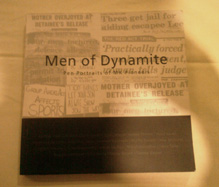
Men of Dynamite honours the lives of South African Indian struggle activists
March 1, 2010 – Men of Dynamite: Pen Portraits of MK Pioneers was launched at the Sci-Bono Centre in Newtown, Johannesburg, last Wednesday, February 24.
Edited by the Nelson Mandela Foundation’s Razia Saleh, Programme Officer for the Centre of Memory, and her husband, Rashid Seedat, the book traces the lives of early Umkhonto we Sizwe (MK) recruits in Fietas (or Vrededorp), Fordsburg, Ferreirastown and central Johannesburg between 1961 and 1964.
Among those featured in the book are long-time friends of Nelson Mandela and the Foundation, Ahmed Kathrada and Mac Maharaj; African National Congress stalwart, Wilton Mkwayi, who died in 2004; as well as relatively unknown MK members Ameen Cajee, Wolfie Kodesh, Kista Moonsamy and Faker Salie.
Published by the Ahmed Kathrada Foundation, the book also contains political activist Maniben Sita’s 1963 diary, which was thought to have been lost; more than 140 photos of the activists at various stages of their lives; as well as lyrics of struggle songs popular at the time.
Saleh explains that Sita’s lost diary came to the Foundation under curious circumstances.
“The diary was found only after she sent a cushion to Nelson Mandela for his 90th birthday. In the cushion she had hidden speeches by Mr Mandela, as well as the diary. Her home was constantly raided by the security police during apartheid, so she had hidden the material in the cushion and forgotten about it.
“She had placed the cushion on her sofa, where it remained undetected over the years.
“When the staff at the Foundation opened the cushion they found, in addition to the speeches, her 1963 diary. She had forgotten that she had also placed the diary in the cushion.
“The contents of the cushion are now with the Foundation’s Centre of Memory.”
Saleh explained, before the launch, that she and her husband had been interested in the idea for the book for some time.
“Ever since Rash and I read the 25th anniversary supplement of Dawn, the monthly Umkhonto we Sizwe journal, a few years ago, we felt the need to tell the story of the ‘Dynamite Coolies’,” said Saleh.
“Indres Naidoo’s story in the journal, which we were particularly drawn to, explains that ‘Dynamite Coolies’ was the name the warders at Leeuwkop Prison gave to the predominantly Indian members of MK, who were held at Leeuwkop before being transferred to Robben Island.
“So we jumped at the opportunity when the idea came up at the discussion for Kathy’s [Ahmed Kathrada’s] 80th birthday celebration in early 2009.”
“The book,” said Seedat at the launch, “is about our heroes. These were the first generation of MK fighters in the Fordsburg area, and our aim was to tell the stories about the personal and political lives of these men.
“In some cases people told their own stories, in other cases we conducted an interview or in some cases, several interviews, to capture their stories.
“The initial idea was to produce a booklet of about 60 pages focusing on Reggie Vandeyar, Shirish Nanabhai, Indres Naidoo and Laloo Isu Chiba as the main protagonists,” said Seedat. “However, as we conducted interviews and research it soon became clear that we had to include all those who formed part of those early MK units in the area that we were researching.
“Because MK units operated clandestinely, the need-to-know principle was applied. So the involvement of some of them was generally unknown except to a few of their close comrades. It is only recently, for example, that Shirish learned that his brother, Narendra ‘Nanoo’ Jasmath, was involved. So, those who successfully escaped police scrutiny remained unknown and in most cases unacknowledged until the production of Men of Dynamite.
“In total there are 24 people profiled, three events and two struggle songs in the book.
“We assembled a group of volunteers who were equally passionate about the project – Lesley Hudson, Taryn Mackay, Lerato Motale Makgobatlou from Cut 2 Black media – and Prema Naidoo and Shabir Ballim, who did research, conducted the interviews and wrote up the stories. Cut 2 Black media also generously made their facilities available for some of the interviews, and most generously sponsored the design and layout of the book.
“Men of Dynamite is not an academic exercise, we make no such claims. It is a popular account, a microcosm of the larger narrative of the struggle against apartheid and the move to the armed struggle. The book focuses on young adults who joined and supported the armed insurgency during its embryonic 1961 to 1964 period. These individuals lived, worked and socialised in the Fordsburg, Fietas (Vrededorp) and Ferreirastown areas, west of the Johannesburg CBD. Due to the infamous Group Areas Act, these pioneers were by and large of Indian origin.”
Speaking at the launch, Kathrada acknowledged the importance of the book in recognising the contribution of members of the Indian population to the struggle, and hoped that this book would lead to many more similar works.
“There are so many heroes and heroines; we hope, in the not too distant future, we will acknowledge the activities and contributions of all those who contributed to the liberation movement,” Kathrada said.
Academic, former political activist and ANC member, Professor Raymond Suttner, highlighted the importance of the book for its contribution towards capturing some of the voices of those involved in South Africa’s liberation struggle. He pointed out that the need to capture other, similar, voices was crucial.
“The importance of this book lies in its contribution towards providing recognition of the Indian community for its contribution to the liberation struggle.
“I’m amazed they managed to squeeze the stories out of these people.
“To say that these people are not boastful is an understatement: most of these people don’t even speak of themselves as ‘I’.
“The need to capture these stories [of people involved in the liberation struggle] is urgent, before they are lost to us forever.”